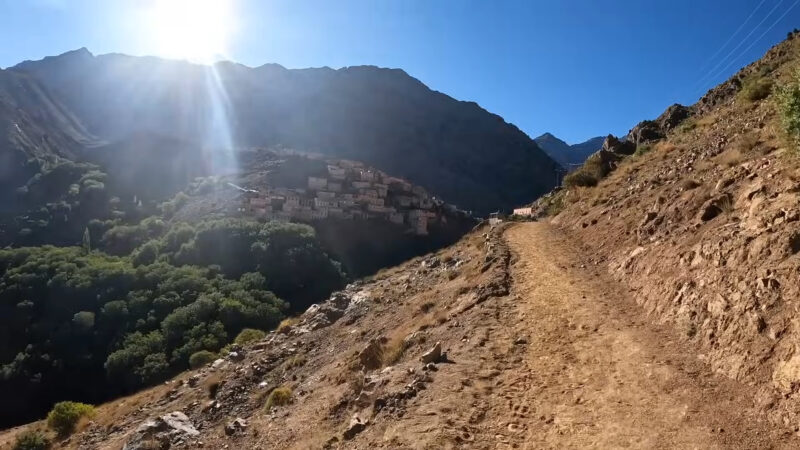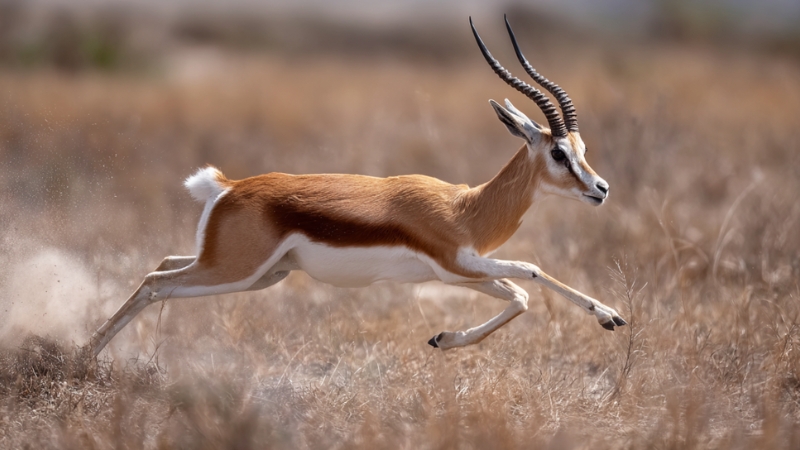Mount Toubkal is the highest peak in North Africa, towering at 4,167 meters. Located in the Atlas Mountains of Morocco, this majestic peak is a favorite among trekkers looking for a rewarding challenge.
Proper planning is essential for a successful Mount Toubkal trek to the summit, as it involves significant altitude and varying terrain.
With the right preparation, the road to the top can be an unforgettable adventure.
Table of Contents
ToggleGetting to Imlil (Starting Point for Mount Toubkal Trek)
Imlil, a village in the High Atlas Mountains, is the gateway to the Mount Toubkal trek and serves as the launching point for many trekkers aiming to conquer North Africa’s highest peak.
Located approximately 65 kilometers from Marrakesh, getting to Imlil is relatively easy, but it’s important to choose the best transportation method based on your preferences and budget.
Transportation Options
Three main transportation options will help with reaching the Mount Toubkal trek you should check out:
| Transport | Cost | Duration | Tips |
|---|---|---|---|
| Taxi | 50-100 MAD per person | 1.5-2 hours | Arrive early, negotiate, confirm if direct or transfer. |
| Car Rental | 200-500 MAD per day + fuel | Depends on driving | Ensure car is suitable, consider 4WD in winter. |
| Public Transportation | 30-50 MAD (bus), 20-30 MAD (shared taxi) | 1.5 hours (bus) + 30 minutes (taxi) | Prepare for delays, time-consuming but cheap. |
Trekking Routes & Stages
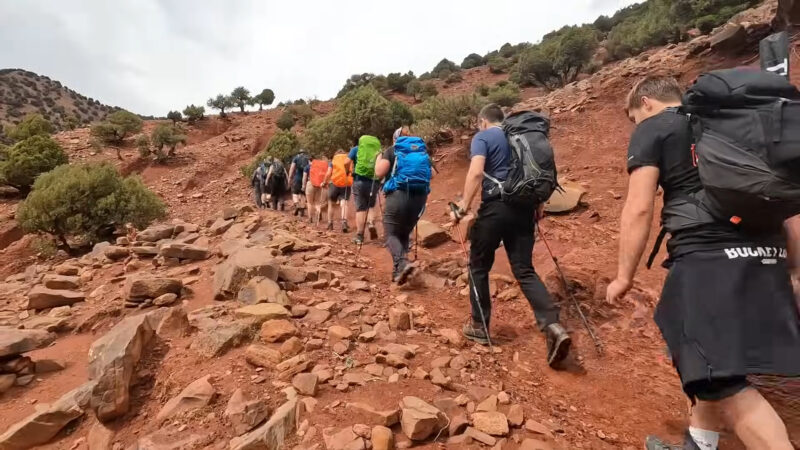
Mount Toubkal offers a variety of trekking routes that cater to different preferences and fitness levels.
The most common options are the 2-day and 3-day treks, but there are also alternative routes for those seeking a more challenging or immersive adventure in the Atlas Mountains.
Standard Route
The standard route is the most popular way to reach the summit of Mount Toubkal and typically starts from Imlil.
- 2-Day Trek: This is the more intense option, ideal for trekkers who are short on time or prefer a faster-paced adventure.
- Day 1: The first day involves trekking from Imlil to the Toubkal Refuge. This leg takes approximately 6-7 hours, covering 12-14 kilometers of steady ascent. You’ll pass through the village of Sidi Chamharouch, a sacred resting place that attracts both pilgrims and trekkers.
- Day 2: On the second day, you’ll make a pre-dawn start to reach the summit of Mount Toubkal. The ascent from the refuge to the summit takes around 3-4 hours, followed by a long descent back to Imlil, making for a full day of trekking.
- 3-Day Trek: For those who want a more relaxed pace, the 3-day trek allows for extra time to acclimate and enjoy the surroundings.
- Day 1: The trek begins with the same route from Imlil to Toubkal Refuge but with more opportunities to stop and explore along the way.
- Day 2: Instead of summiting, trekkers can spend an extra day at the refuge, enjoying shorter hikes around the area or simply relaxing and acclimating.
- Day 3: On the third day, trekkers will make the ascent to the summit and descend back to Imlil at a more comfortable pace.
Day-by-Day Breakdown
- Day 1:
- Start your trek from Imlil early in the morning.
- The path takes you through the Aroumd Valley and up towards Sidi Chamharouch, where many trekkers stop for lunch.
- Continue the ascent to the Toubkal Refuge, where you’ll spend the night. The total distance covered is around 12 kilometers, and the elevation gain is roughly 1,200 meters.
- Day 2:
- Start your trek from the refuge before dawn to reach the summit in time for sunrise. The final ascent involves steep and rocky terrain, but the panoramic views from the top make it worthwhile.
- After reaching the summit, take time to enjoy the stunning views of the Atlas Mountains and the Sahara Desert in the distance.
Descend back to Imlil, passing through the same landmarks, but at a faster pace, since the downhill path is less strenuous. This second day can take up to 10 hours in total, depending on your pace.
Interesting Fact: A 6-year-old girl is the younger person who climbed Mount Toubkal.
Physical Preparation
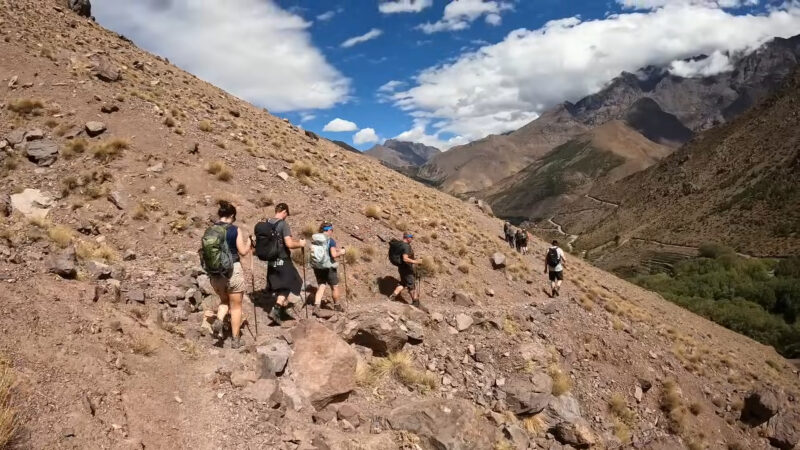
Mount Toubkal trek is a physically demanding activity, and ensuring you are properly prepared is essential for a safe and enjoyable experience. The trek involves significant elevation gain, rugged terrain, and the added challenge of high altitude, which can take a toll on even seasoned hikers.
To tackle Mount Toubkal successfully, physical readiness in terms of endurance, strength, and acclimatization to altitude is vital.
Fitness Requirements
Before embarking on your trek, it’s important to train your body to handle the rigors of mountain hiking. Here are key areas to focus on:
Cardiovascular Fitness
Mount Toubkal requires stamina, as you will be walking for several hours a day, often at a steady incline. To build your endurance, engage in cardiovascular exercises that increase your heart rate and improve your breathing efficiency.
- Recommended Activities: Running, cycling, swimming, or brisk walking are excellent ways to improve cardiovascular fitness. Aim for at least 30-60 minutes of cardiovascular exercise, 3-5 times per week, in the months leading up to your trek.
- Hiking Practice: If possible, incorporate hiking into your training, especially on hilly or mountainous terrain. This will help you acclimate to the physical demands of trekking over uneven surfaces.
Strength Training
Since you’ll be carrying a backpack and navigating steep slopes, it’s crucial to develop strength in your legs, core, and shoulders. Leg muscles, in particular, will bear most of the burden, especially during the ascent.
Focus Areas:
- Leg Strength: Incorporate exercises such as squats, lunges, and step-ups to build your quadriceps, hamstrings, and calves.
- Core Stability: A strong core helps maintain balance on uneven terrain. Planks, Russian twists, and leg raises are effective core exercises.
- Upper Body: Your upper body will help carry your backpack, so exercises like push-ups, rows, and shoulder presses can strengthen these muscles.
Altitude Acclimatization
One of the most challenging aspects of trekking Mount Toubkal is the altitude. The summit stands at 4,167 meters (13,671 feet), and exposure to high altitude can lead to altitude sickness if you’re not properly acclimatized.
To reduce the risk of altitude sickness, it’s advisable to spend time at moderate elevations (around 2,000-3,000 meters) before your trek. If you have the opportunity, take hikes at higher altitudes or stay in mountainous regions to help your body adjust.
At higher altitudes, the air pressure decreases, leading to lower oxygen levels. Your body needs time to adapt to these conditions by producing more red blood cells to carry oxygen.
Gear and Clothing
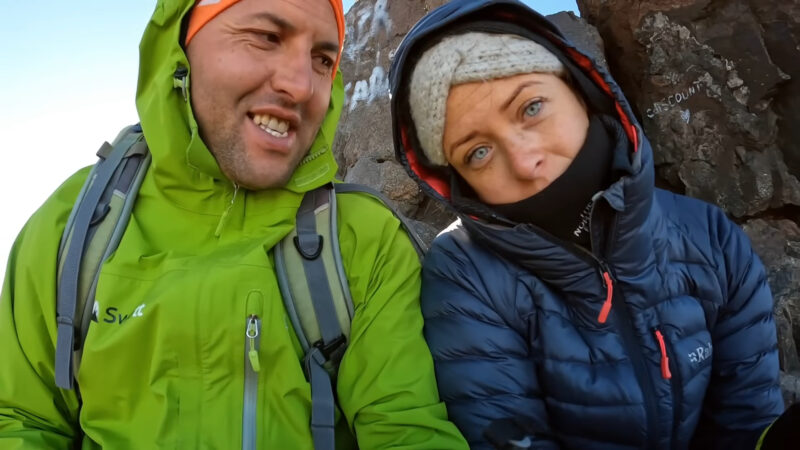
Having the right gear and clothing is crucial for a comfortable and safe trek to Mount Toubkal.
Essential Gear:
- Hiking Boots: Sturdy and already broken in to prevent blisters.
- Crampons: Necessary during the winter months when the trail is icy.
- Layered Clothing: Temperatures can vary greatly, so dress in layers.
Packing List:
- Passport: Required at checkpoints.
- Snacks: High-energy foods like peanuts, dried fruits, and energy bars.
- Sunscreen & First-Aid Kit: To protect against the sun and treat minor injuries.
- Emergency Whistle: In case of emergencies on the trail.
Carrying the right gear ensures that you are prepared for any weather conditions and situations on the mountain.
Weather and Best Time to Visit
Choosing the right time to trek Mount Toubkal is crucial for a safe and enjoyable experience.
Seasonal Variations:
- Best Time: May to September is ideal for trekking, with mild weather and clear paths.
- Winter Conditions: Colder temperatures and snow can make the trek more challenging, requiring additional gear like crampons.
- Be prepared for sudden changes in weather by packing rain gear and cold-weather clothing.
The right timing can significantly enhance your trekking experience, making the journey more manageable and enjoyable.
Safety Considerations

Trekking Mount Toubkal comes with its share of risks, especially related to altitude and emergencies.
- Symptoms include headaches, nausea, and dizziness.
- Prevention: Acclimatize by spending extra days at higher altitudes, staying hydrated, and pacing your ascent.
Emergency Preparedness:
- Police Checkpoints: Several checkpoints along the route ensure safety and emergency response.
- Insurance: Medical insurance that covers high-altitude trekking is recommended.
Taking the necessary safety precautions will help prevent mishaps and ensure a safe and enjoyable trek.
The Bottom Line
Trekking Mount Toubkal offers an unforgettable adventure through the stunning Atlas Mountains.
With proper planning, physical preparation, and the right gear, you’ll be set for an exhilarating climb to North Africa’s highest peak.
Plan ahead, be prepared, and enjoy the incredible experience that awaits!

